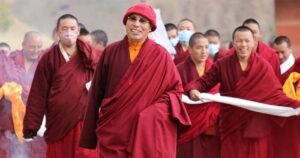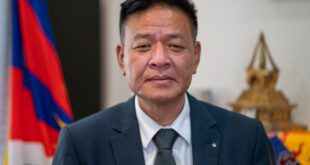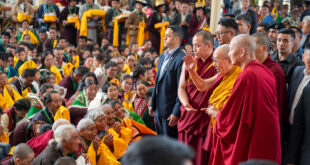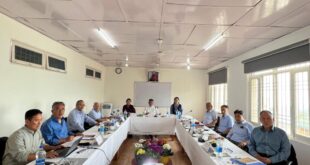November 03, 2011
Chairman McGovern, Chairman Wolf, Commission Members, thank for giving me the opportunity to testify before the Tom Lantos Human Rights Commission.
This is my first visit to Washington, D.C., since assuming the office of Kalon Tripa of Tibet following the historic transfer of political authority by His Holiness the Dalai Lama earlier this August.
The late Tom Lantos has a special place in the hearts of the Tibetan people. He was a dear friend to His Holiness the Dalai Lama and his message of compassion. He was an eloquent and passionate advocate for the cause of Tibet and the Tibetan people’s quest for dignity. We are proud that the House of Representatives has honored his legacy by putting his name on this esteemed commission dedicated to the promotion of human rights.
The commission itself is also special for Tibetans. In 1987, its predecessor, the Congressional Human Rights Caucus, was the first parliamentary body to give His Holiness the Dalai Lama a public audience. For this we extend our utmost gratitude.
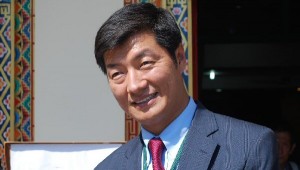
The United States Congress has been the vanguard of the Tibet cause for more than two decades. We are deeply grateful for the invaluable support, both programmatic and policy that you have provided over the years. The benefits of this support are real and tangible. A young Tibetan refugee who has fled her home in Tibet is now able to get a real Tibetan education in India that is unavailable in occupied Tibet under the People’s Republic of China. She benefits from the United States humanitarian aid that provides an essential lifeline to the refugees who make the dangerous transit across the Himalayas, throughNepal, and into exile.
Take the example of the monks of Tongren, who lit fireworks last year to celebrate the meeting between President Obama and the Dalai Lama, in defiance of Chinese attempts to undermine his influence. They heard about this through the Voice of America and Radio Free Asia Tibetan services, which provide a vital link to the outside world in the face of Chinese attempts to seal off Tibet.
In very difficult times, American support keeps Tibetans’ spirits up and their hopes alive – hopes that the future may bring change that will allow Tibetans to reclaim their dignity and their fundamental freedoms. The seven Tibet programs supported by the United States government are very small in your budget, but their impact in the lives of Tibetans is immense and, I believe, a smart investment toward your country’s efforts to promote democracy and human rights.
I come here to report to you on the state ofTibet– the daily struggles of Tibetans inside Tibet trying to maintain their dignity under the iron fist of repression, and the continuing efforts of those of us living in freedom, working to preserve Tibetan culture in exile until we can return home.
I am proud to say that the Tibetan spirit is strong. Through the brilliant leadership of His Holiness the Dalai Lama for all these years, our issue remains alive, our hopes remain buoyant. The rule imposed on us byBeijingmay be tough, but the Tibetan people are tougher still.
Democratic transition: The year 2011 has been a momentous one in the history ofTibet. Since the 17th century, His Holiness the Dalai Lama has served as both the spiritual and the temporal leader of the Tibetan people. The current Dalai Lama, the 14th, Tenzin Gyatso, held political office as the head of the local Tibetan government based in Lhasa, Tibet, before he was forced to flee into exile in 1959.
In the following decades, the Dalai Lama quietly proceeded to dismantle the traditional theocratic ¬aristocratic system and, with his wisdom, prepared the Tibetan people for the day when they would have to be their own leaders. In 1960, Tibetans in exile elected their first parliament. In 1991, we had the first direct election of the chief executive.
And in March of this year, His Holiness announced he would relinquish the last vestiges of his formal political role in the government. These changes, ratified by our parliament, put the leadership of the Tibetan people in the hands of the elected leadership – the executive branch (under the Kalon Tripa) and the parliament.
A few days after His Holiness’s announcement, the Tibetan exile community held an historic vote. In elections that were judged free and fair by international observers, the Tibetans elected me as the next Kalon Tripa, with 55 percent of the vote, and a new 44 member parliament.
Let me be clear, this does not mean that the Dalai Lama has retired. He remains the spiritual and most revered leader of the Tibetan people, and is identified as such in the Tibetan Charter (our constitution). He continues to travel the world and meet with world leaders, as he did with President Obama this past July.
This democratic transition is an important one for theUnited Statesto absorb. Recall that in 1991, in legislation signed into law by the first President Bush, Congress declared that, “Tibet’s true representatives are the Dalai Lama and the Tibetan Government in exile as recognized by the Tibetan people.” The Tibetan Policy Act of 2002 directs the State Department’s Special Coordinator for Tibetan Issues to “maintain close contact with religious, cultural, and political leaders of the Tibetan people.” The U.S.government already engages with the Central Tibetan Administration, notably in regard to the Tibetan support programs. It is worth the effort to consider how the world’s oldest continuous democracy can deepen its engagement with the democratic Tibetan government.
This democratic fulfillment is also important in the context of the “Arab spring” and the new wave of democratic, anti-despotic movements. The last few years have witnessed democratization not only in the Tibetan government based in northernIndia, but in Bhutan and Nepal, countries on the southern periphery to Tibet and the People’s Republic ofChina. This follows the democratic achievements in the 1980s and 1990s in Taiwan, South Korea, and the Philippines, on China’s eastern rim.
The Tibetan fulfillment of democracy provides inspiration to all those inside the People’s Republic ofChina, not just Tibetans, who yearn for the democratic freedoms long denied by the ruling Communist Party. It clearly undermines the (false) notion peddled by Beijing that democracy is a western value not suitable to an Asian context.
Further, this achievement sends a clear message to Beijing that leadership of the Tibet freedom movement has been entrusted to a younger generation. Chinais calculating that the Tibetan cause will fade when the current Dalai Lama passes. This will not happen.
In short, American investment in Tibetan democracy is a wise one and on the right side of history.
Of theUnited Statesand the international community, we ask you to:
(1) Affirm thatTibet’s true representatives are the Dalai Lama and the Central Tibetan Administration as recognized by the Tibetan people;
(2) Support the transfer of political power to the new Kalon Tripa ofTibetand the Parliament in Exile of the Central Tibetan Administration;
(3) Commend the Tibetan exile community on their successful development and implementation of democratic self-governance;
Middle Way approach on Tibet-China relations: The Tibetan people remain firmly committed to non-violence. We do not viewChinaas a nation and Chinese as a people with malice but with respect. Tibetans and their distinct culture have lived alongside our Chinese brothers and sisters for thousands of years.
When His Holiness appeared before the Human Rights Caucus in 1987, he presented his “five point peace plan,” one of the first articulations of his ‘Middle Way’ approach before an international audience. Guided by his wisdom, my administration will continue the Middle Way policy, which seeks genuine autonomy for Tibet within the People’s Republic ofChina. This remains the best opportunity for a durable solution for both the Tibetan and Chinese peoples. We believe in a peaceful resolution for Tibet, which means a peaceful process and peaceful dialogue. We stand ready to negotiate with the Chinese government anytime, anywhere.
Repression and religious freedom in Tibet: In 2008, Tibetans across the Tibetan plateau rose up in dramatic and largest protest of Chinese policies. Since that time, more than 150 separate protests have taken place across the Tibetan plateau. Sadly, rather than responding to the legitimate grievances of Tibetans, Chinese authorities responded by making a hard line harder, turning many parts of Tibet into a virtual state of martial law. This has driven the Tibetan people to a desperate situation.
In 1950, when the Chinese and their Army of “liberation” came toTibet, they promised Tibetans a ‘socialist paradise.’ After more than 60 years of misrule inTibet, there is no socialism, just colonialism; there is no paradise, only tragedy.
Political repression, cultural assimilation, economic marginalization and environmental destruction continue in occupied Tibet. The new railway line from Beijing to Lhasa is exporting our natural resources and importing more Chinese migrants. Today, around 70 percent of private-sector firms in Tibet are owned or run by Chinese and more than 50 percent of government officials are Chinese. Yet approximately 40 percent of Tibetans with university and high school degrees are unemployed.
I recall a photo of a help-wanted sign from Lhasaa couple years ago. A shop was looking to hire Tibetans at 30 renminbi and Chinese at 50 renminbi, a blantant case of economic discrimination. Tibetans have been made second-class citizens in their own land.
The U.S.government has consistently found that repression in Tibet is “severe,” as documented in annual State Department reports on human rights and religious freedom and the reporting by the Congressional-Executive Commission onChina. Chinese authorities impose extremely rigid regulations on day-to-day religious activity. Acts of religious devotion are seen suspiciously as expressions of political separatism. To revere openly His Holiness the Dalai Lama can be considered a criminal act. Monks and nuns routinely encounter interference in their ability to conduct teaching and practice of Tibetan Buddhist religious traditions.
The Tibetan religious community has been particularly affected during the recent crackdown. A case study can be made in the town of Ngaba (Chinese province of Sichuan, Tibetan area of Amdo).
Kasur Kirti Rinpoche who will testify after me will attest that since 1996 Kirti Monastery, and others in the region, have been targeted for “patriotic education,” or political indoctrination. Local schools that were started by Kirti monastery’s sister monastery in Kansu were forcibly shut down, cutting off basic education to rural children, which was deeply resented by the monastic and lay communities in the region. Kirti Rinpoche, who fled into exile in 1959, has only been allowed to visit Ngaba once, in the 1980s. His visa request to travel toTibethas been repeatedly denied. Monks at Kirti monastery revere him as their spiritual head and hold him in as high a regard as the Dalai Lama. These policies create deep resentment among the people in the area.
It is in this context that we have seen the tragic self-immolations of ten Tibetans, all but one from around Kirti monastery, to protest against Chinese government policies, demand freedom and the return of His Holiness the Dalai Lama. Tibetans are being pushed to the brink. We all wonder what we can do in the face of this tragic situation. The Tibetan Cabinet recently held a day-long special prayer service, including His Holiness the Dalai Lama, His Holiness the Karmapa and Kiri Rinpoche, in solidarity with those Tibetans who have sacrificed their lives for the cause of Tibet.
The Tibetan administration does not encourage or support self-immolations. While we feel the pain of those Tibetans sacrificing themselves, at the same time, as Buddhists, we can’t help but wish that their precious lives were not lost. His Holiness the Dalai Lama’s position has been clear and consistent on any form of drastic action. He has always appealed to the Tibetans not to resort to such desperate acts.
We ask the Chinese government to stop its repressive policies, including suspension of implementation of religious control regulations, review of religious and security policies implemented since 2008 in Ngaba, and a transparent dialogue with the leaders of Tibetan Buddhist schools.
Of the United States and the international community, we ask you to:
(1) call on China to abide by its obligations to international human rights conventions with respect to the religious freedoms and basic human rights of the monastic and lay communities in Ngaba, and seek a full accounting of the forcible removal of monks from Kirti monastery;
(2) demand access to Ngaba by journalists, diplomats and United Nations officials;
(3) call on the China to stop implementing counterproductive policies and aggressive ‘patriotic education’ programs in Tibetan-populated areas such as Sichuan, Gansu and Qinghai, places where human rights violations have created tensions; and
(4) urge the Chinese government to resume its dialogue with the representatives of the Dalai Lama toward genuine autonomy for Tibetans within the People’s Republic of China.
Reincarnation/succession: No issue illustrates the Chinese government’s desire to control the hearts and minds of the Tibetan people, and demonstrates it moral bankruptcy, more than the attempt to dictate the reincarnation of the Dalai Lama. It may be complicated, but it is not esoteric. This issue is not only a matter of fundamental religious freedom, but it is a political one that gets to the heart of the Tibet problem.
In 2007, the Chinese authorities approved regulations requiring government approval for the recognitions of lamas as reincarnate “tulkus.” Government bureaucracies must approve reincarnations of high lamas, and the State Council reserves the right to deny recognition. The rules state that no foreign entity can interfere in the selection of reincarnate lamas, and require all reincarnate lamas to be reborn within the PRC.
The purpose and position of the Chinese government is very clear: only it can approve the next Dalai Lama.
This situation, of course, is absurd. The Chinese Communist Party, synonymous with the government, is officially atheist. Their leadership has never believed in reincarnation and treats religion as poison. They have no experience, and certainly no right, to interfere in matter of the heart and of the spirit.
On September 24, 2011, the Dalai Lama gave a statement laying out his position. Citing the tenets of Tibetan Buddhism and centuries of practice and tradition, His Holiness makes the case that (1) the future of the institution of the Dalai Lama is up to the Tibetan people, and (2) that he will determine whom his successor will be, either through a process of reincarnation or emanation of his spirit.
The coming political fight is clear. The Chinese authorities will attempt to hijack the process for selecting the next Dalai Lama, exactly as they did with the 11th Panchen Lama 16 years ago, in the hopes it will extinguish the distinct Tibetan identity. In this they will fail. I am confident that Tibetan people and Buddhists around the world will whole heartedly follow the guidance of the 14th Dalai Lama, and embrace the boy or girl that is his true successor.
Buddhism has been around for 2,500 years, the Chinese Communist Party for merely 90. I believe we will outlast them. I ask members of the Commission, on behalf of the Congress and the U.S. government, to see the battle over the Dalai Lama’s succession as a fundamental issue of religious freedom worthy of advocacy and protection. On this issue, I recommend that the U.S. government:
(1) join with other governments around the world to adopt a unified position on the successor to the Dalai Lama, based on fundamental principles of religious freedom; and
(2) express to the Chinese government that the United States believes that the relationship between the Dalai Lama and the Tibetan people will be solely determined by the Tibetan people.
Refugee resettlement: Since 1959 the Tibetan exile community has persevered due to the tremendous generosity of our Indian hosts. The government and people of India gave us lands to settle and to farm. But after half a century, these settlements are aging. Infrastructure is crumbling. Our human capital is thinning. Our sustainability is at risk.
One of the biggest challenges I face as Kalon Tripa is how to revitalize the Tibetan refugee settlements in India and Nepal so that they can continue to serve as the foundation for our efforts to preserve Tibetan culture until the time we can re-import it back to Tibet.
Education will be the number one priority of my administration. We seek to create 10,000 Tibetan professionals in the next two decades. We will establish a Tibet Policy Institute to serve as an intellectual platform to envision, develop, and execute policies that will strengthen Tibet. We will create also “sister settlements” to strengthen solidarity between Tibetans in India and the West and launch Tibet Corps which offers talented community-minded Tibetan professionals and college students an opportunity and platform to serve their community through a voluntary service program.
Our settlements are crowded. While we must revitalize, there is also a need to have Tibetan refugees settle in countries outside of India and Nepal. As His Holiness has long advocated, a vibrant Tibetan diaspora in the West is an essential element in our effort to maintain global support for the Tibetan cause.
To advance these two goals, the United States has already contributed much. In 2009, Congress approved $2 million in the Foreign Operations bill for settlement revitalization. We are currently working with USAID on the final disposition of these funds. We are deeply grateful for this aid.
In an act of foresight two decades ago, Congress approved legislation granting immigration status to 1,000 Tibetans from India. This program was successfully implemented, at no cost to the taxpayer. In the current Congress, Congressmen Jim Sensenbrenner and George Miller have introduced H.R. 699, to initiate a new and limited immigration program for Tibetans. Tibetan-American communities now exist across the country and are ready and able to receive a new round of immigrants. This legislation would help fulfill His Holiness’ vision.
While Tibetans in South Asia are strong in spirit, self-reliant, and determined to reunite our people, we are still refugees. Those in India, while appreciative of Indians’ generosity, do not enjoy full rights. They live in special settlements. They cannot go home to Tibet due to a legitimate fear of persecution. Those in Nepal face additional hardships. Three quarters lack documentation, which the government of Nepal has failed to provide. They suffer harassment due to the heavy pressure exerted by China in Nepal.
The U.S. government is successfully executing the resettlement of Bhutanese refugees from Nepal, relieving the Nepalese of one intransigent refugee problem. The U.S. government has proposed to resettle some Tibetans from Nepal, but this has not been approved by the Nepalese government.
Resettlement of Tibetan refugees from Nepal, and from the most remote and destitute settlements in India, is another path to achieving His Holiness’ goal. It would also serve U.S. foreign policy goals in Nepal. In this light, I recommend that Congress:
(1) approve H.R. 699, the Tibetan immigration bill; and
(2) urge the Administration to resettle Tibetan refugees from South Asia, including the Nepal program that is already on the table, and a potential India program that would target Tibet refugees in the most marginal communities.
Tibet’s environment and strategic importance: Tibet sits between two of the largest countries in the world, and at a crossroads that connects China to South and Central Asia. The Tibetan plateau has some of the largest deposits of fresh water outside the two poles. It is the source of many of the Asia’s major rivers, including the Yarlung Tsangpo (Brahmaputra), Senge Khabab (Indus), the Langchen Khabab (Sutlej), the Macha Khabab (Karnali), Arun (Phongchu), the Gyalmo Ngulchu (Salween), the Zachu (Mekong), the Drichu (Yangtse)and Machu (Huang he or Yellow River), these rivers flow into China, India, Pakistan, Nepal Bhutan, Bangladesh, Burma, Thailand, Vietnam, Laos and Combodia. These rivers system and their tributaries sustains the lives of millions of people in the Asian continent.
For millennia, the Tibetan people have served as the guardians of the plateau, its rivers and environment. China’s policies, however, are creating potential disasters. For one, they are forcibly removing Tibetan nomads, the land’s traditional stewards, from the grasslands, while at the same time promoting mining and foresting. Changes in Tibet’s ecology could have negative effects far beyond the plateau. Temperatures are rising faster on the plateau than the global average. Glaciers are melting. Water flows and monsoon patterns are more variable.
At the same time, China is undertaking massive dam construction on these major rivers. Additional projects to divert waters to China’s drought-ridden areas could have major consequences for downstream nations like India, Bangladesh, Cambodia and Laos whose livelihood depends on rivers that flow from Tibet.
The United States should work in partnership with other nations to promote a multilateral framework on regional water sharing, in order avoid potential conflicts over water resources.
In addition, China is building out new railway lines through Tibet and into Nepal, expanding their economic, political and military reach into South Asia. Newly built airfields in Tibet offer the Chinese military new possibilities for power projection to the nation’s south and west.
Conclusion: This year’s dynamic events – the Tibetan election and His Holiness’ devolution of power — showed the world our commitment to genuine democracy and the universal principle of human freedom. Through this achievement, we are demonstrating that Tibetan unity is built upon and sustained by universal democratic principles that transcend region, sect, gender, and generations. With this unity, we can strengthen and sustain the Tibet movement until the time that His Holiness returns to Tibet and the Tibetan people regain their freedom.
China is the fastest growing major economy in the world and is backed by the largest army in the world. Sadly, however, China lacks moral power, which cannot be purchased in the market or imposed with military might. It has to be earned. As long as Tibetans are repressed, there will be resistance and a continuation of this moral deficit. Finding a lasting solution to the Tibet question will go a long way toward restoring China’s positive image in the minds and hearts of people around the world, as well as towards protecting its territorial integrity and sovereignty. We will continue to reach out to the Chinese people to build mutual understanding and trust.
I look forward to the day when the United States can look with pride that, through its political and programmatic support, it helped nurture a lasting solution to the Tibet problem. Such an achievement would be one of the most defining stories of the 21st century, as it would reaffirm faith in humanity’s capacity to build peace, non-violence and universal freedom. This would be a victory not only for the Tibetan people, but for all the marginalized people around the world.

